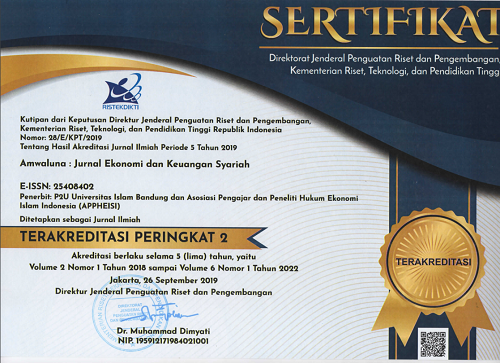BUSINESS MANAGEMENT DEVELOPMENT STRATEGY IN MICRO, SMALL AND MEDIUM ENTERPRISES
Abstract
Domestic MSMEs that are highly competitive, innovative and creative are able to expand the ASEAN Economic Community market. However, there are problems that often hinder the development of MSMEs in Deli Serdang Regency, namely weak institutional and individual factors, for this reason efforts are needed to increase the growth of MSMEs with competitive strategies, especially in facing the AEC. The method used is a literature study using descriptive analysis techniques and qualitative research. The results of this research are Porter's Five Forces model consisting of: threat of new entrants, strength of supplier's bargaining position, strength of buyer's bargaining position, threat of substitute or substitute products, strength of competition or competitors, has not been sufficiently applied to MSMEs in Deli Serdang Regency and is very It is necessary to develop a model with the addition of 2 more indicators that will support MSMEs to be able to survive, compete and excel in facing the ASEAN Economy. Community (AEC), namely: Governance, Innovation Capability and Mastery of Technology, Effective Low Cost Strategy for MSMEs in Deli Serdang Regency. This can be seen from the expected goals for business actors (MSMEs), namely being able to increase profits by reducing costs and setting prices which is in accordance with the average industry and business actors (MSMEs), can increase market share by applying lower prices and still achieve or obtain adequate profits from each sale of products or services because costs have been reduced.
Keywords
Full Text:
PDFReferences
Aaker, D. (1995). Strategic Market Management. John Willey & Sons, Inc.
Alma, B. (2004). Marketing Management and Service Marketing. Bandung: CV. Alphabeta.
Amirullah, d. I. (2005). Introduction to Business, First Edition. Yogyakarta: Graha Ilmu.
Chandra I. Robby. (1998). Business World Ethics. (Yogyakarta : Kanisius, 1998), p. 20. Yogyakarta: Canisius, p. 20.
Gitosudarmo, I. (1993). Financial Management. Yogyakarta: BPFE.
Finance, K. (2023, June 23). Directorate general of Treasury. Retrieved from https://djpb.kemenkeu.go.id/kppn/lubuksikaping/id/data-publikasi/artikel/3134-kontribusi-umkm-dalam-perekonomian-indonesia.html: https://djpb.kemenkeu.go.id/kppn/lubuksikaping/id/data-publikasi/artikel/3134-kontribusi-umkm-dalam-perekonomian-indonesia.html
Kusmuljono, B. (2009). Public Private Partnership Policy: system approach to microfinancing case on Indonesia. Bogor: IPB Press.
Muslich. (2004). Islamic Business Ethics. Yogyakarta: Econesia, h 18-20.
Porter, M. (1980). Competitive Strategy Techniques forAnalysing Industries and Competitors. New York: The Free Press.
Porter, M. (1985). Competitive Advantage: Creating and Sustaining Superior Performance. English: The Free Press.
Rangkuti, F. (2013). Creative promotion strategies and case analysis. Jakarta: Gramedia Main Library.
Sandiasa, G. d. (2017). Policy on Strengthening Empowerment Institutions in Increasing Community Empowerment Participation in Rural Areas. Locus Scientific Magazine Fisip, 64-78.
Schein, E. H. (2008). Organizational Culture and Leadership. Third Edition, 2.
Soeprihanto, M. S. (2005). Introduction to Business. (Yogyakarta: Liberty, 2005), p. 21.
Sugiyono. (2017). Quantitative, qualitative, and R&D Research Methods. Bandung : Alfabeta, 2017, p.8.
Terry, G. R. (2010). Fundamentals of Management. Jakarta: Bumi Aksara.
Wahyuni, E. D. (2020). Empowering Aisyiyah Management by Strengthening Business Management. Journal of Community Service and Quality Improvement, 13-17.
Wijayanti, I. D. (2008). Management. Yogyakarta: Mitra Cendikia.
DOI: https://doi.org/10.29313/amwaluna.v6i1.12960
Refbacks
- There are currently no refbacks.
Editorial Office:
Syariah Faculty, Universitas Islam Bandung
Jalan Tamansari No. 24-26 Kota Bandung

Amwaluna : Jurnal Ekonomi dan Keuangan Syariah is licensed under a Creative Commons Attribution-NonCommercial-ShareAlike 4.0 International License.







